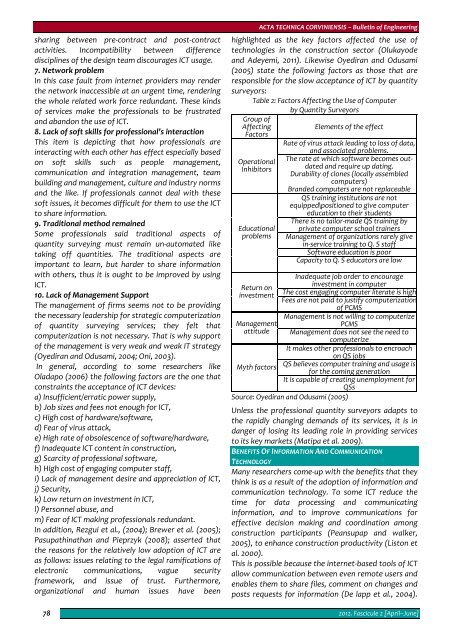Editorial & Advisory Board - Acta Technica Corviniensis
Editorial & Advisory Board - Acta Technica Corviniensis
Editorial & Advisory Board - Acta Technica Corviniensis
Create successful ePaper yourself
Turn your PDF publications into a flip-book with our unique Google optimized e-Paper software.
sharing between pre‐contract and post‐contract<br />
activities. Incompatibility between difference<br />
disciplines of the design team discourages ICT usage.<br />
7. Network problem<br />
In this case fault from internet providers may render<br />
the network inaccessible at an urgent time, rendering<br />
the whole related work force redundant. These kinds<br />
of services make the professionals to be frustrated<br />
and abandon the use of ICT.<br />
8. Lack of soft skills for professional’s interaction<br />
This item is depicting that how professionals are<br />
interacting with each other has effect especially based<br />
on soft skills such as people management,<br />
communication and integration management, team<br />
building and management, culture and industry norms<br />
and the like. If professionals cannot deal with these<br />
soft issues, it becomes difficult for them to use the ICT<br />
to share information.<br />
9. Traditional method remained<br />
Some professionals said traditional aspects of<br />
quantity surveying must remain un‐automated like<br />
taking off quantities. The traditional aspects are<br />
important to learn, but harder to share information<br />
with others, thus it is ought to be improved by using<br />
ICT.<br />
10. Lack of Management Support<br />
The management of firms seems not to be providing<br />
the necessary leadership for strategic computerization<br />
of quantity surveying services; they felt that<br />
computerization is not necessary. That is why support<br />
of the management is very weak and weak IT strategy<br />
(Oyediran and Odusami, 2004; Oni, 2003).<br />
In general, according to some researchers like<br />
Oladapo (2006) the following factors are the one that<br />
constraints the acceptance of ICT devices:<br />
a) Insufficient/erratic power supply,<br />
b) Job sizes and fees not enough for ICT,<br />
c) High cost of hardware/software,<br />
d) Fear of virus attack,<br />
e) High rate of obsolescence of software/hardware,<br />
f) Inadequate ICT content in construction,<br />
g) Scarcity of professional software,<br />
h) High cost of engaging computer staff,<br />
i) Lack of management desire and appreciation of ICT,<br />
j) Security,<br />
k) Low return on investment in ICT,<br />
l) Personnel abuse, and<br />
m) Fear of ICT making professionals redundant.<br />
In addition, Rezgui et al., (2004); Brewer et al. (2005);<br />
Pasupathinathan and Pieprzyk (2008); asserted that<br />
the reasons for the relatively low adoption of ICT are<br />
as follows: issues relating to the legal ramifications of<br />
electronic communications, vague security<br />
framework, and issue of trust. Furthermore,<br />
organizational and human issues have been<br />
78<br />
ACTA TECHNICA CORVINIENSIS – Bulletin of Engineering<br />
highlighted as the key factors affected the use of<br />
technologies in the construction sector (Olukayode<br />
and Adeyemi, 2011). Likewise Oyediran and Odusami<br />
(2005) state the following factors as those that are<br />
responsible for the slow acceptance of ICT by quantity<br />
surveyors:<br />
Table 2: Factors Affecting the Use of Computer<br />
by Quantity Surveyors<br />
Group of<br />
Affecting<br />
Elements of the effect<br />
Factors<br />
Rate of virus attack leading to loss of data,<br />
Operational<br />
Inhibitors<br />
Educational<br />
problems<br />
Return on<br />
investment<br />
Management<br />
attitude<br />
Myth factors<br />
and associated problems.<br />
The rate at which software becomes outdated<br />
and require up dating.<br />
Durability of clones (locally assembled<br />
computers)<br />
Branded computers are not replaceable<br />
QS training institutions are not<br />
equipped\positioned to give computer<br />
education to their students<br />
There is no tailor‐made QS training by<br />
private computer school trainers<br />
Management of organizations rarely give<br />
in‐service training to Q. S staff<br />
Software education is poor<br />
Capacity to Q. S educators are low<br />
Inadequate job order to encourage<br />
investment in computer<br />
The cost engaging computer literate is high<br />
Fees are not paid to justify computerization<br />
of PCMS<br />
Management is not willing to computerize<br />
PCMS<br />
Management does not see the need to<br />
computerize<br />
It makes other professionals to encroach<br />
on QS jobs<br />
QS believes computer training and usage is<br />
for the coming generation<br />
It is capable of creating unemployment for<br />
QSs<br />
Source: Oyediran and Odusami (2005)<br />
Unless the professional quantity surveyors adapts to<br />
the rapidly changing demands of its services, it is in<br />
danger of losing its leading role in providing services<br />
to its key markets (Matipa et al. 2009).<br />
BENEFITS OF INFORMATION AND COMMUNICATION<br />
TECHNOLOGY<br />
Many researchers come‐up with the benefits that they<br />
think is as a result of the adoption of information and<br />
communication technology. To some ICT reduce the<br />
time for data processing and communicating<br />
information, and to improve communications for<br />
effective decision making and coordination among<br />
construction participants (Peansupap and walker,<br />
2005), to enhance construction productivity (Liston et<br />
al. 2000).<br />
This is possible because the internet‐based tools of ICT<br />
allow communication between even remote users and<br />
enables them to share files, comment on changes and<br />
posts requests for information (De lapp et al., 2004).<br />
2012. Fascicule 2 [April–June]

















